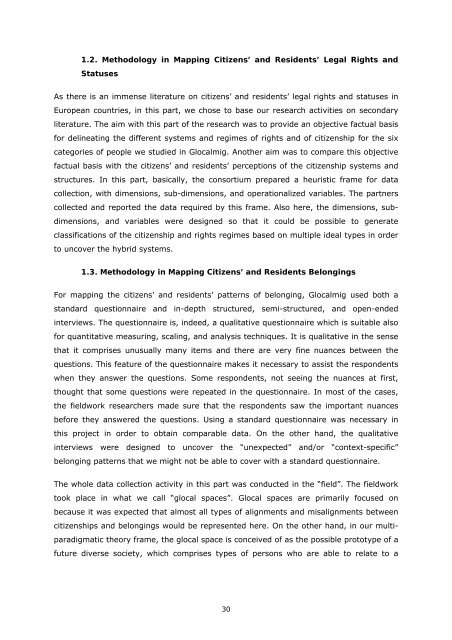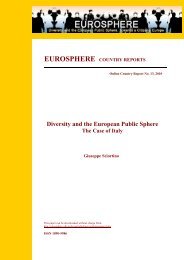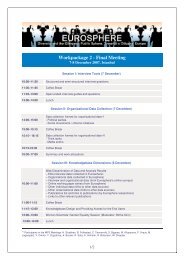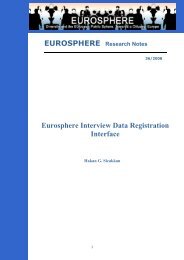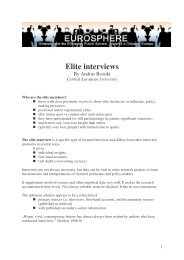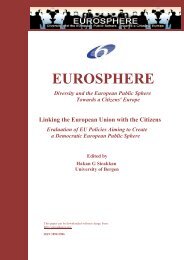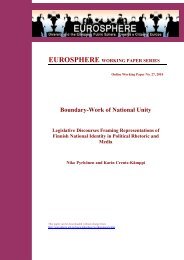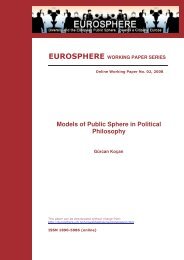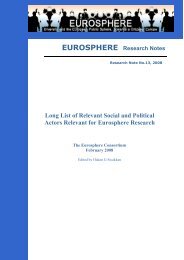Migrants, Minorities, Belongings and Citizenship. Glocalization and ...
Migrants, Minorities, Belongings and Citizenship. Glocalization and ...
Migrants, Minorities, Belongings and Citizenship. Glocalization and ...
Create successful ePaper yourself
Turn your PDF publications into a flip-book with our unique Google optimized e-Paper software.
1.2. Methodology in Mapping Citizens’ <strong>and</strong> Residents’ Legal Rights <strong>and</strong><br />
Statuses<br />
As there is an immense literature on citizens’ <strong>and</strong> residents’ legal rights <strong>and</strong> statuses in<br />
European countries, in this part, we chose to base our research activities on secondary<br />
literature. The aim with this part of the research was to provide an objective factual basis<br />
for delineating the different systems <strong>and</strong> regimes of rights <strong>and</strong> of citizenship for the six<br />
categories of people we studied in Glocalmig. Another aim was to compare this objective<br />
factual basis with the citizens’ <strong>and</strong> residents’ perceptions of the citizenship systems <strong>and</strong><br />
structures. In this part, basically, the consortium prepared a heuristic frame for data<br />
collection, with dimensions, sub-dimensions, <strong>and</strong> operationalized variables. The partners<br />
collected <strong>and</strong> reported the data required by this frame. Also here, the dimensions, subdimensions,<br />
<strong>and</strong> variables were designed so that it could be possible to generate<br />
classifications of the citizenship <strong>and</strong> rights regimes based on multiple ideal types in order<br />
to uncover the hybrid systems.<br />
1.3. Methodology in Mapping Citizens’ <strong>and</strong> Residents <strong>Belongings</strong><br />
For mapping the citizens’ <strong>and</strong> residents’ patterns of belonging, Glocalmig used both a<br />
st<strong>and</strong>ard questionnaire <strong>and</strong> in-depth structured, semi-structured, <strong>and</strong> open-ended<br />
interviews. The questionnaire is, indeed, a qualitative questionnaire which is suitable also<br />
for quantitative measuring, scaling, <strong>and</strong> analysis techniques. It is qualitative in the sense<br />
that it comprises unusually many items <strong>and</strong> there are very fine nuances between the<br />
questions. This feature of the questionnaire makes it necessary to assist the respondents<br />
when they answer the questions. Some respondents, not seeing the nuances at first,<br />
thought that some questions were repeated in the questionnaire. In most of the cases,<br />
the fieldwork researchers made sure that the respondents saw the important nuances<br />
before they answered the questions. Using a st<strong>and</strong>ard questionnaire was necessary in<br />
this project in order to obtain comparable data. On the other h<strong>and</strong>, the qualitative<br />
interviews were designed to uncover the “unexpected” <strong>and</strong>/or “context-specific”<br />
belonging patterns that we might not be able to cover with a st<strong>and</strong>ard questionnaire.<br />
The whole data collection activity in this part was conducted in the “field”. The fieldwork<br />
took place in what we call “glocal spaces”. Glocal spaces are primarily focused on<br />
because it was expected that almost all types of alignments <strong>and</strong> misalignments between<br />
citizenships <strong>and</strong> belongings would be represented here. On the other h<strong>and</strong>, in our multiparadigmatic<br />
theory frame, the glocal space is conceived of as the possible prototype of a<br />
future diverse society, which comprises types of persons who are able to relate to a<br />
30


